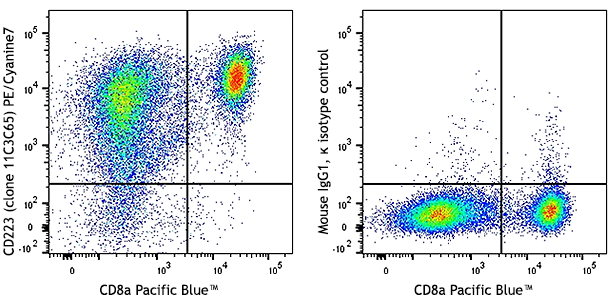- Clone
- F38-2E2 (See other available formats)
- Regulatory Status
- RUO
- Workshop
- HCDM listed
- Other Names
- T cell immunoglobulin and mucin domain containing protein 3, hepatitis virus cellular receptor 2, CD366
- Isotype
- Mouse IgG1, κ
- Ave. Rating
- Submit a Review
- Product Citations
- publications

-

Th1-polarized human peripheral blood mononuclear cells were stained with CD4 FITC and anti-human CD366 (Tim-3, clone F38-2E2) PE (top) or mouse IgG1, κ PE (bottom). -

| Cat # | Size | Price | Quantity Check Availability | Save | ||
|---|---|---|---|---|---|---|
| 345005 | 25 tests | 123€ | ||||
| 345006 | 100 tests | 288€ | ||||
CD366 (Tim-3) is a transmembrane protein also known as T cell immunoglobulin and mucin domain containing protein-3. Tim-3 is expressed at high levels on activated T cells (preferentially on Th1 cells, monocytes/macrophages, and dendritic cells). Tim-3 has also been shown to exist as a soluble protein. Cells expressing Tim-3 are present at high levels in the CNS of animals at the onset of experimental autoimmune encephalomyelitis (EAE), a disease mediated by lymphocytes secreting Th1-like cytokines. Tim-3 has been proposed to inhibit Th1-mediated immune responses and promote immunological tolerance.
Product DetailsProduct Details
- Reactivity
- Human
- Antibody Type
- Monoclonal
- Host Species
- Mouse
- Immunogen
- Human Tim-3 fusion protein
- Formulation
- Phosphate-buffered solution, pH 7.2, containing 0.09% sodium azide and BSA (origin USA)
- Preparation
- The antibody was purified by affinity chromatography, and conjugated with PE under optimal conditions.
- Concentration
- Lot-specific (to obtain lot-specific concentration and expiration, please enter the lot number in our Certificate of Analysis online tool.)
- Storage & Handling
- The antibody solution should be stored undiluted between 2°C and 8°C, and protected from prolonged exposure to light. Do not freeze.
- Application
-
FC - Quality tested
- Recommended Usage
-
Each lot of this antibody is quality control tested by immunofluorescent staining with flow cytometric analysis. For flow cytometric staining, the suggested use of this reagent is 5 µl per million cells in 100 µl staining volume or 5 µl per 100 µl of whole blood.
- Excitation Laser
-
Blue Laser (488 nm)
Green Laser (532 nm)/Yellow-Green Laser (561 nm)
- Application Notes
-
Additional reported applications (for relevant formats of this clone) include: costimulation1 (clone 2E2 has been shown to enhance T-cell receptor mediated activation and cytokine secretion) and blocking2,3.
- Application References
-
- Hastings WD, et al. 2009. Eur. J. Immunol. 39:2492. (Costim)
- Jones RB, et al. 2008. J. Exp. Med. 205:2763. (Block)
- Klibi J, et al 2009. Blood 113:1957. (FC, Block)
- Product Citations
- RRID
-
AB_1877236 (BioLegend Cat. No. 345005)
AB_2116576 (BioLegend Cat. No. 345006)
Antigen Details
- Structure
- Transmembrane protein containing immunoglobulin domain and mucin-like domain; can exist as a soluble form lacking mucin and transmembrane domains
- Distribution
-
Activated T cells, preferentially on Th1 cells, monocytes, dendritic cells
- Function
- Plays a role in regulating macrophage activation, T cell apoptosis and immune tolerance
- Ligand/Receptor
- Galectin-9
- Cell Type
- Dendritic cells, Monocytes, T cells, Th1, Tregs
- Biology Area
- Immunology, Inhibitory Molecules
- Molecular Family
- CD Molecules, Immune Checkpoint Receptors
- Antigen References
-
1. Hafler DA and Kuchroo V. 2008. J. Exp. Med. 205:2699.
2. Zhu C, et al. 2005. Nat. Immunol. 6:1245.
3. Wang F, et al. 2009. Immunobiology 214:342. - Gene ID
- 84868 View all products for this Gene ID
- UniProt
- View information about CD366 on UniProt.org
Related Pages & Pathways
Pages
Related FAQs
- What type of PE do you use in your conjugates?
- We use R-PE in our conjugates.
Customers Also Purchased
Compare Data Across All Formats
This data display is provided for general comparisons between formats.
Your actual data may vary due to variations in samples, target cells, instruments and their settings, staining conditions, and other factors.
If you need assistance with selecting the best format contact our expert technical support team.
 Login / Register
Login / Register 

















Follow Us